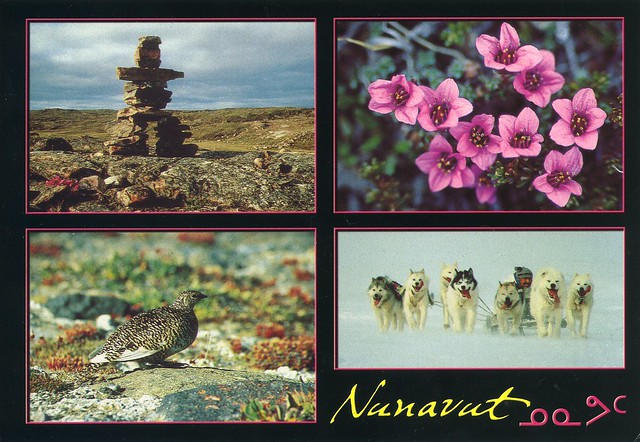A lovely card from back in 2009. Alas, this wasn't mailed from Canada but I don't really mind too much when the card is this beautiful and I had had it in my favourites for a while.
Clockwise from top left: The Inuksuk, Purple Saxifrage, Canadian Inuit Dog, The Rock Ptarmigan.
Nunavut is the largest, northernmost and newest territory of Canada. It was separated officially from the Northwest Territories on April 1, 1999, via the Nunavut Act and the Nunavut Land Claims Agreement Act, though the boundaries had been contemplatively drawn in 1993. The creation of Nunavut resulted in the first major change to Canada's political map since the incorporation of the new province of Newfoundland and Labrador in 1949.
Nunavut comprises a major portion of Northern Canada, and most of the Canadian Arctic Archipelago. Its vast territory makes it the fifth-largest country subdivision in the world, as well as the second-largest in North America after Greenland. The capital Iqaluit (formerly "Frobisher Bay") on Baffin Island, in the east, was chosen by the 1995 capital plebiscite. Other major communities include the regional centres of Rankin Inlet and Cambridge Bay. Nunavut also includes Ellesmere Island to the far north, as well as the eastern and southern portions of Victoria Island in the west and Akimiski Island in James Bay to the far south. It is the only geo-political region of Canada that is not connected to the rest of North America by highway.
Nunavut is both the least populous and the largest in area of the provinces and territories of Canada. One of the most remote, sparsely settled regions in the world, it has a population of 31,906, mostly Inuit, spread over a land area the size of Western Europe. Nunavut is also home to the northernmost permanently inhabited place in the world, Alert. A weather station farther down Ellesmere Island, Eureka, has the lowest average annual temperature of any weather station in Canada.
Subscribe to:
Post Comments (Atom)




 Maroon
Maroon 










































































































































































No comments:
Post a Comment